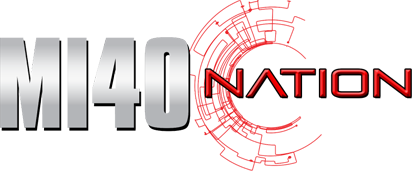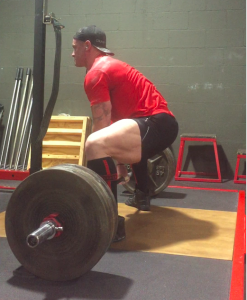MI40 Strength: Intro to Coach Adam, & Boss of Bosses Meet – Part 2
In case you missed it, catch Part 1 here. Now, during my prep for this meet I had the best training ...

In case you missed it, catch Part 1 here. Now, during my prep for this meet I had the best training ...
First off, congratulations if you understood my pun. Folic acid or Folate is also known as vitamin B9. The name ...
Question: “Let’s say we have your average trainee who works out four of five times a week, working each bodypart ...
Everybody's familiar with testosterone, the grand daddy hormone most synonymous with both muscle and manhood. Today we provide a comprehensive ...
The ‘BURN’... both masochistically loved and hated at the same time. We’ve all felt it. We’ve all heard varying opinions ...
Of the major neurotransmitters, acetylcholine just might be the most important from a muscle building standpoint. As a major neurotransmitter ...
If you eat a well balanced "healthy" diet, are supplements REALLY necessary to optimize progress? Learn some surprising reasons why ...
Did you know that your body is approximately 90% bacteria and only 10% human? From birth to death, our gut ...
In today’s society, emphasis is placed on work and productivity over anything else. This could mean sacrificing quality of nutrition ...
In preparation for writing this article, I wanted to see what exactly was written out on the web when it ...
One of the best strategies you can apply with success to a bodybuilders diet is protein rotation. In essence, eating ...
Question: “Will taking simple carbs after a workout negate the effect of growth hormone production from your workout and kill ...
The Deadlift is not a Squat!
Where the hips start in the deadlift is dependent upon a person’s anthropometrics (it’s a matter of how you are built). During a squat there is a nice balance between knee extension and hip extension working sequentially. In the deadlift, the bar is out in front of you during the pull. This position allows for little to no moment arm for the knee joint as the bar should be against your shin as you pull; therefore the leg extensors have very little effect on the deadlift when they are compared to the squat.
You can experience this with that trap/hex bar deadlift – most people can deadlift more weight when using a trap/hex bar simply because the knees can shift forward and create a longer moment arm, thus allowing the leg extensors to really contribute to the lift. The trap/hex bar does not have the hindrance of the bar having to start and stay in front of you during the lift (as depicted below).
The Deadlift’s Prime Mover is Not the Low Back!
This is the biggest mistake I see made during the deadlift. Correct deadlift technique can add slabs of muscle to your back, but not the way everyone generally perceives it.
Let me explain…
When you want to add muscle to your biceps, you use concentric and eccentric contractions to cause a homeostatic stress to the system; the system comes back bigger and stronger. While in the deadlift, the eccentric and concentric contraction should not occur at your low back (i.e; your spine in spinal flexion / extension). It should occur at the hips, in hip extension / flexion. The spinal erectors (low back) will receive stress from an isometric contraction holding the spine stable and neutral.
The prime movers in the deadlift are those muscles that control hip extension:
Every Good Deadlift will Follow Certain Principals:
> Principal 1
No matter where someone starts the deadlift, hips high or hips low, the bar will ultimately break from the floor with a vertical shin angle. There may be a very slight forward angle, but this is not optimal as the bar will move towards you as you pull, and we want it to go straight up.
> Principal 2
No matter if you have short arms, long arms, short torso, long torso etcetera, when the bar breaks from the floor it will ultimately be underneath your shoulder- girdle. You don’t want the bar away from your shins at this point because, once again, it will shift back on to you. Why would we let the bar move horizontally when we want it to move vertically, straight up!
Besides, if the bar is not under your shoulder-girdle as you pull, that would be one heck of a front deltoid isometric hold!
> Principal 3
The major limiting factor in the deadlift is hip extension torque – the ability for the hips to extend.
Heavy loads are not, “missed”, because you are weak in the movement. The lift is, “missed”, because your weakest link in the movement could not overcome the load. In general, if you want to improve your deadlift, train your hip extensors, not your low back.
> Principal 4 (Advanced)
 When pulling heavy loads, athletes will often start with a lower hip position (relative to their own anthropometrics) to increase the amount of assistance their quads have within the movement. The novice athlete will sometimes be taken forward by this if not prepared. The novice athlete will often times try to lift from a lower hip position, but when the bar breaks from the floor they are not ready to handle the weight and can often times be pulled forward or off balance.
When pulling heavy loads, athletes will often start with a lower hip position (relative to their own anthropometrics) to increase the amount of assistance their quads have within the movement. The novice athlete will sometimes be taken forward by this if not prepared. The novice athlete will often times try to lift from a lower hip position, but when the bar breaks from the floor they are not ready to handle the weight and can often times be pulled forward or off balance.
If you watch a video of yourself and notice that when the bar breaks from the floor your shins move away from the bar, then you may need to pull from a lower hip position.
If the bar breaks from the floor and it looks like you are doing an RDL (Romanian Deadlift), but your shins are against the bar, this is your body’s anthropometrics (long arms and short torso), and no amount of training with a lower hip position will help.
The deadlift may be the most misunderstood exercise in the gym, so take these tips and understand what you are actually trying to accomplish with this great lift – too many lifters never utilize this lift to its true potential because they lack some simple biomechanical understanding of what is actually occurring.
Adam Miller – MI40 Strength Coach
Resources:
Nuckols G. 2014. Everything you think is wrong with your deadlift is probably right [Internet] Available from http//www.strengtheory.com/everything-you-think-is-wrong-with-your-deadlift/
Rippetoe M. Starting Strength: Basic Barbell Training. 3rd ed. The Asgaard Company 2011